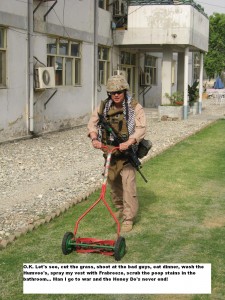Poppy’s anyone?
September 10th, 2008 Posted in The SandGram v1.0Hey guys,
I bet you didn’t know that Afghanistan produces around 90% of the world’s heroin. Well they do and it’s amazing that the farmers would plant something they can’t eat and then complain that there is a wheat shortage. The other night, the boys were sitting around discussing what they had been up to. One of the guys told about how they have this poppy eradication program where they go in and pay a farmer to plow his poppy crop over. This one farmer gladly took the money from the American’s, sat back and patiently watched as they plowed over his poppy crop and all the time had a smile on his face. This was puzzling until later when they studied Poppy’s better and figured out that this guy had already harvested his crop of poppy’s and thanks to the American’s, his field was plowed and he had some extra cash for next years crop. Who ever said these guys were dumb…
So, here is a short piece on the making of Heroin that was on one of our talking papers someone found on the internet I’m sure.
Semper Fi,
Taco
Heroin’s long journey to America’s streets begins with the planting of the seed of an opium poppy. The flower’s botanical name is papaver somniferum. The Sumerians called it Hul Gil, the ‘flower of joy.’
The flower is grown mainly by impoverished farmers on small plots in remote regions of the world. It flourishes in dry, warm climates and the vast majority of opium poppies are grown in a narrow, 4,500-mile stretch of mountains extending across southern Asia from Turkey through Pakistan and Laos. Heroin is also increasingly becoming an export from Latin America, notably Colombia.
About three months after the poppy seeds are planted, brightly-colored flowers bloom at the tips of greenish, tubular stems. As the petals fall away, they expose an egg-shaped seed pod. Inside the pod is an opaque, milky sap. This is opium in its crudest form.
The sap is extracted by slitting the pod vertically in parallel strokes with a special curved knife. As the sap oozes out, it turns darker and thicker, forming a brownish-black gum. A farmer collects the gum with a scraping knife, bundles it into bricks, cakes or balls and wraps them in a simple material such as plastic or leaves.
Then the opium enters the black market. A merchant or broker buys the packages for transport to a morphine refinery. “Most traffickers do their morphine refining close to the poppy fields, since compact morphine bricks are much easier to smuggle than bundles of pungent, jelly-like opium,” writes Alfred W. McCoy in The Politics of Heroin.
At the refinery, which may be little more than a rickety laboratory equipped with oil drums and shrouded in a jungle thicket, the opium is mixed with lime in boiling water. A precipitate of organic waste sinks to the bottom. On the surface a white band of morphine forms. This is drawn off, reheated with ammonia, filtered and boiled again until it is reduced to a brown paste.
Poured into molds and dried in the sun, it is now morphine base, which has the consistency of dense modeling clay. Morphine base is smokable in a pipe – a practice introduced by the Dutch in the 17th century – or ready for further processing into heroin.
The first to process heroin was C.R. Wright, an English researcher who unwittingly synthesized heroin (diacetylmorphine) in 1874 when he boiled morphine and a common chemical, acetic anhydride, over a stove for several hours. The modern technique entails a complicated series of steps in a good laboratory.
In his book, Opium A History, Martin Booth describes the process: “First, equal quantities of morphine and acetic anhydride are heated in a glass or enamel-lined container for six hours at 85ÉC. The morphine and the acid combine to form impure diacetylmorphine. Second, water and chloroform are added to the solution to precipitate impurities. The solution is drained and sodium carbonate added to make the heroin solidify and sink. Third, the heroin is filtered out of the sodium carbonate solution with activated charcoal and purified with alcohol. [Fourth,] this solution is gently heated to evaporate the alcohol and leave heroin, which may be purified further …”
Purification in the fourth stage, involving ether and hydrochloric acid, is notoriously risky. “In the hands of a careless chemist the volatile ether gas may ignite and produce a violent explosion that can level a clandestine laboratory,” writes McCoy. The final product is a fluffy, white powder known in the trade as number four heroin.
When the heroin emerges from laboratories in places such as Bangkok or Hong Kong, it enters a multi-layered chain of distribution. Top brokers usually deal in bulk shipments of 20 to 100 kilos. A broker in New York might divide a bulk shipment into wholesale lots of 1 to 10 kilos for sale to underlings. A kilo of Southeast Asian heroin in 1997 costs $100,000 to $120,000, according to the Drug Enforcement Administration.
Oddly, for a shadowy commerce, the one-kilo bricks are brightly packaged and imprinted with brands worthy of Madison Avenue. Heroin originating in Burma’s Shan State, for example, sports a red-lettered logo, “Double UO Globe Brand”, framed by a pair of lions.
By the time heroin is peddled on city streets in small “bags” at $5 to $100, its value has ballooned more than ten- fold since its arrival in the United States.
Not many years ago virtually all the heroin sold on America’s streets was so heavily diluted that it was rarely more than 10 percent pure. Purity has risen sharply in the mid-’90’s – routinely hitting 50 to 60 percent – as dealers have tried to expand their market beyond those addicts who inject heroin into their veins with hypodermic needles. Higher purity means “you can inhale it, you can smoke it, you can get high without the threat of AIDS or those nasty intravenous needles.” says DEA administrator Thomas Constantine, in a recent Washington Post story.
Greater purity also reflects a relatively high level of worldwide production. Last year the illicit output of raw opium amounted to a record 4,300 tons, an increase of almost 1000 tons since 1992, according to U.S. estimates. Burma’s 1996 share of more than 2500 tons made it, far and away, the world leader.
By an age-old rule of thumb, every 10 tons of raw opium reduces to one ton of heroin. In other words, the worldwide opium output in 1996 translates into 430 tons of heroin. About half of that is destined for the United States.





